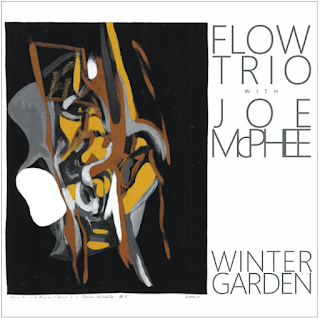By
Kenneth Blanchard
Ken Vandermark is a virtuoso on at least two instruments. One is the
saxophone. Two is the impossible integration device. The various Vandermark
5 recordings were certainly instrumental in the ontogeny of my ear
for jazz. Each V5 recording gave me something that I could hear and
comprehend, as well as something that shocked and puzzled me. I am also a
connoisseur of great titles: Airports of Light, Elements of Style, The Color of Memory.
Jazz composers sometimes appear as frustrated painters. Consider William
Parker’s Painter’s Spring and
Painter’s Winter
. By chance, I suppose, this is the second recording I have covered
recently that counts as much as performance art as jazz. Vandermark, I
learn from the booklet that came with the recording, was inspired by
another famous recording: Alvin Lucier’s I Am Sitting in a Room.
I confess that I have not experienced the entire 45 minutes of Lucier’s
recording, but I did listen to part of it all the way through. You
can listen to it here. It
consists of short speech repeatedly recorded and played again. Very quickly
the feedback reduces the words to an incoherent hum. The key to the word
“stammer” can be heard in the first statement of Lucier’s text.
Vandermark more or less reverses the direction of coherence: giving us
snippets of speech or dialogue, that come into intelligible focus only on
occasion. This happens just behind the spread of compelling free jazz.
Well, it did create in yours truly a desire for a French beret and a
pipeful of hashish. Having neither on hand, I can still say that I was
pleasantly propelled by Momentum 5.
One more reason for that lies in another word in the title: triptych. In
the liner notes, KV informs us that he was inspired by
Max Beckmann’s painting: The Actors
(1942). I strongly recommend viewing Beckmann’s triptych before you listen
to Vandermark’s Triptych. And while you are at it, take a look at
Hieronymus Bosch’s The Garden of Earthly Delights (c. 1480 to
1505) and Francis Bacon’s Triptych (1944). Bosch’s trip may
explain why Beckmann’s trip has a guy with a fish running down from his hat
to his ass. Momentum 5 is a triptych (three panel painting)
because it consists of three untitled tracks, each a hair over twenty
minutes, punctuated by two short tracks.
Bandcamp lists the personnel as: Kim Alpert (visuals), Tim Barnes
(percussion), Katinka Kleijn (cello), Damon Locks (samples/electronics),
Nick Macri (basses), Lou Mallozzi (recordings/electronics), claire rousay
(percussion), and Mars Williams (saxophones/little instruments). I gather
that the Bandcamp download contains a video, but I have not seen it.
The tracks have numbers but no other title. Track 1 begins with a sax
flutter, quickly joined by percussion, which is quite vivid throughout. At
about one minute, the vocal background begins. What sounds like a clip from
NPR is the first coherent snip. Something about a boy being dragged off a
bus by the police. Other clips seem to be dialogue, and some give us the
effect of a mike in a room with lots conversations going on. In a voice
that seems to pin down an irritated mother, we hear this: “you’re not Santa
Claus you know… we expect to see you more than once a year.” The clips are
repeated many times.
The music almost always cloaks the speech. It is classic free jazz in a
classic Vandermark vein. If the music crowds out the words that we are
tempted to try to hear, the instruments never crown out one another. I
really like the sound of heavy strings, accompanied by long, emotive horn
notes. There is plenty of that here.
In track 3 we get an explicit, technologically generated stutter. The bits
of voice become increasingly distorted, sometimes slowed into a smear, and
sometimes tightened into a helium-chipmunk effect. The middle of the track
raises tempo, volume, and lets the crowd-voice sound compete with the
instruments.
The final track begins with a rare stretch of coherent dialogue: apparently
someone kicking off some kind of conference. The verbal material becomes
much more prominent but increasingly distorted at the same time.
Now I can listen to Vandermark and this ensemble all day, pretty much any
day. I nevertheless find his project a bit frustrating. I have the
impression that, if I could just spend enough time listening to it, I would
get out of it a fair portion of what he invested. I can’t. Very few people
ever could.
I’m not recommending against the purchase or the listen. I do think this
sort of project puts the difficulties of an art fan, in a world awash with
projects, right up front.
In addition to the recording, there is a film (or is it the other way
round?). The Stammer film is a literal triptych: three rectangular screens
against a black background. Each screen displays colorful, frenetic,
intricate patterns. A narrative voice, persistently distorted, pronounces
snippets of dialogue that mostly seem to come out of a small meeting room,
or a court rooms, or a political speech. The left screen gradually begins
printing fragments of phrases. I think the flashing art on the screens is
built up from vertical and horizontal lines. A loaf of bread, a tab of
acid, and thou… .







































